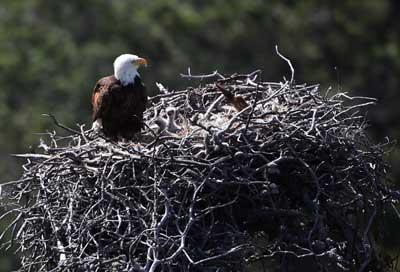Efforts to reestablish a bald eagle population in Channel Islands National Park reached another important milestone when scientists confirmed the successful natural hatching of a chick on West Anacapa Island.
The last known successful nest on Anacapa Island dates back to 1949. This is also believed to be the first successful hatching of a bald eagle anywhere in Ventura County during that same period.
“This new milestone with a bald eagle chick on Anacapa Island is very exciting,” said Channel Islands National Park Superintendent Russell Galipeau. “Bald eagles are now breeding on four of the eight Channel Islands that they occupied historically.”
Records indicate that bald eagles bred on all islands within the park in the past, with at least two dozen nesting pairs over the eight Channel Islands. The eagles disappeared from the islands by the early 1960s due to human impacts, primarily DDT and PCB contamination. The effects of these chemicals are magnified in the food chain, causing bald eagles to lay thin-shelled eggs that dehydrate or break in the nest.
Today there are between 60 to 70 bald eagles living on the Channel Islands as a result of multi-agency restoration efforts that included raising and releasing bald eagle chicks on Santa Cruz Island between 2002 and 2006.
There are 13 active nests with 12 chicks this breeding season, including three nests on Santa Cruz Island, two on Santa Rosa Island, one on Anacapa Island, and seven on Santa Catalina Island. Of the four islands in the park, Anacapa is the closest to the mainland.
Biologists are optimistic about continued expansion of the number of breeding bald eagles and the number of islands with active bald eagle nests.
The bald eagle pair responsible for the chick on Anacapa has been together since 2009. The nest on Anacapa, their first known attempt at breeding, was discovered in March with two eggs. The status of the second egg is unknown.
The male, known as A-21, was brought from Alaska as an eight-week-old chick and released on Santa Cruz Island in 2003. The female, A-11, was also originally from Alaska and released on Santa Cruz Island in 2002.




Add comment